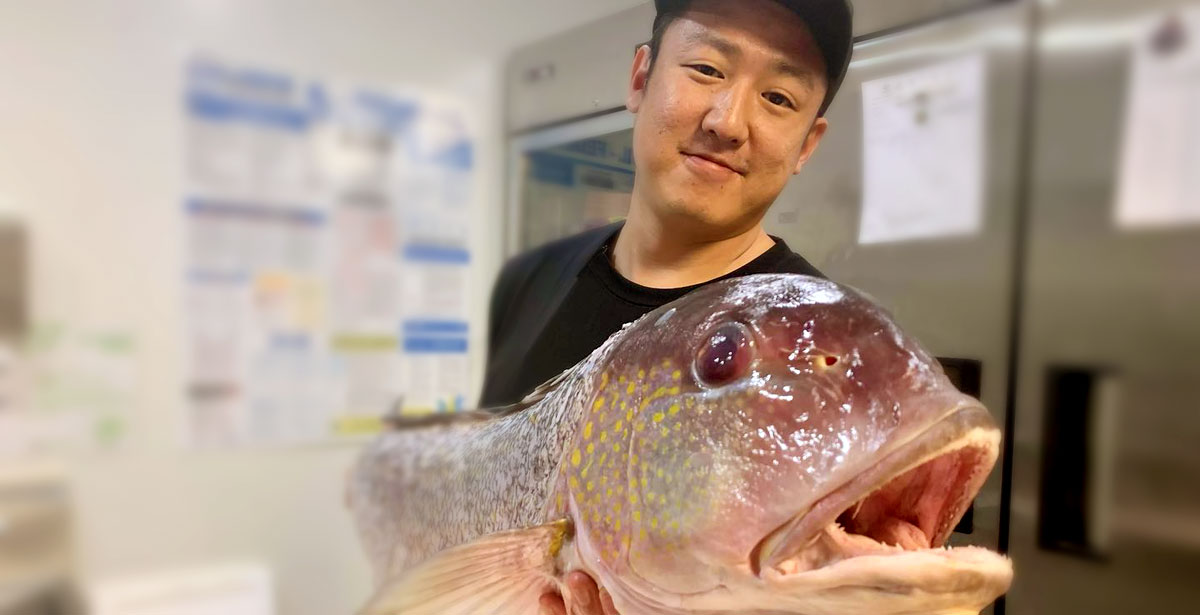I’ve never been to Japan, but I’ve always been a fan of Japanese food. Mitsuwa Marketplace in Arlington Heights is one of our regular stops on Chicago weekend trips, and Kofusion is one of our favorite local joints for sushi (even though owner Janet Bubin is Korean, we owe her our loyalty because she was the first entrepreneur in Illinois to serve sushi outside of Chicago when she opened Miko in 1991).
Although sushi is most associated with Japan, it was originally invented in China in the third century B.C. Today sushi is ubiquitous all over the world — in the States, most supermarkets have a sushi counter and even Thai restaurants now offer sushi. Despite the fact that soba and ramen are more popular in Japan than sushi, Americans have really embraced the Makizushi, especially the version invented in California. The best way to eat sushi is not to order from the menu at all, and let the sushi chef create a custom meal just for you.
At high end sushi bars in New York City or San Francisco, the prized seat is at the sushi bar, in front of the sushi chef. When you take your seat, you are usually greeted with a loud “Irasshaimase!” (“Welcome!”) and immediately offered a free bite of something appetizing. If presented with a menu, your response should be “omakase” (“I leave it up to you.”). Depending on your response (facial expressions, body language, the sounds you might make as you take your first bite), the sushi chef will subtly adjust the next course he will serve you. Like a good tailor, he will custom design a meal just for you that will fit you like a glove. Before Google reviews existed, omakase feasts were only for the super-rich; that is, unless you took some time to become a regular at your favorite local sushi joint and got to know the sushi chef personally.
Now, we can do just that in Champaign-Urbana at ISHI, a relatively new but still “secret” sushi bar run by Ken Ishibashi who is currently offering an eight-course prix fixe tasting menu. Thanks to Smile Politely (here, here, and here), the “secret” is already out and getting a coveted seat at his sushi bar is getting more challenging all the time. I had to wait a month before I had the privilege to be served at ISHI for the first time. We were warned ahead of time that ISHI does not have a liquor license yet, and that’s a deal breaker for me — a sushi feast is not really complete without sake. Fortunately, ISHI encourages diners to bring their own booze, so my first stop before this special event was the Common Ground Food Co-op which stocks an excellent selection of premium sake. I bought almost one each of every brand of sake in stock. I stashed all of them in my fridge to chill overnight in anticipation of the special day. Tip: in Japan, only low grade sake is served hot in order to mellow out its harshness.

Photo by Paul Young.
The next day, I drove to a nondescript building with a sign that read “Kirby Food & Liquor.” This is the same building that used to house an excellent Korean grocer and Yellowfin, one of our old favorite sushi joints. Without any signage, I felt like I was entering a super-secret speakeasy during prohibition days. That’s a good feeling in my book.

Photo by Paul Young.
When we entered, Chef Ishibashi was still finishing up the previous omakase seating, so we sat in the waiting area until he was ready for us. We were a party of four, and since Ken only takes eight customers per seating, there was also another party of four waiting with us. A handwritten blackboard welcomed us which clearly stated the price of the omakase tasting menu ($49 per person, $40 for seniors and veterans) plus today’s offering of fresh baked goods from Kaori’s Oven. Kaori is Ken’s partner in life as well as in this unique venture. In other words, this is an authentic mom-and-pop family-run corner restaurant. Ken handles the fish, and Kaori runs the bakery side and doubles as a waitress. Their two kids come to work with them, and they even have their own play area. This very informal atmosphere felt like we had been invited into Ken and Kaori’s home for a private dinner which makes the whole experience even more special.
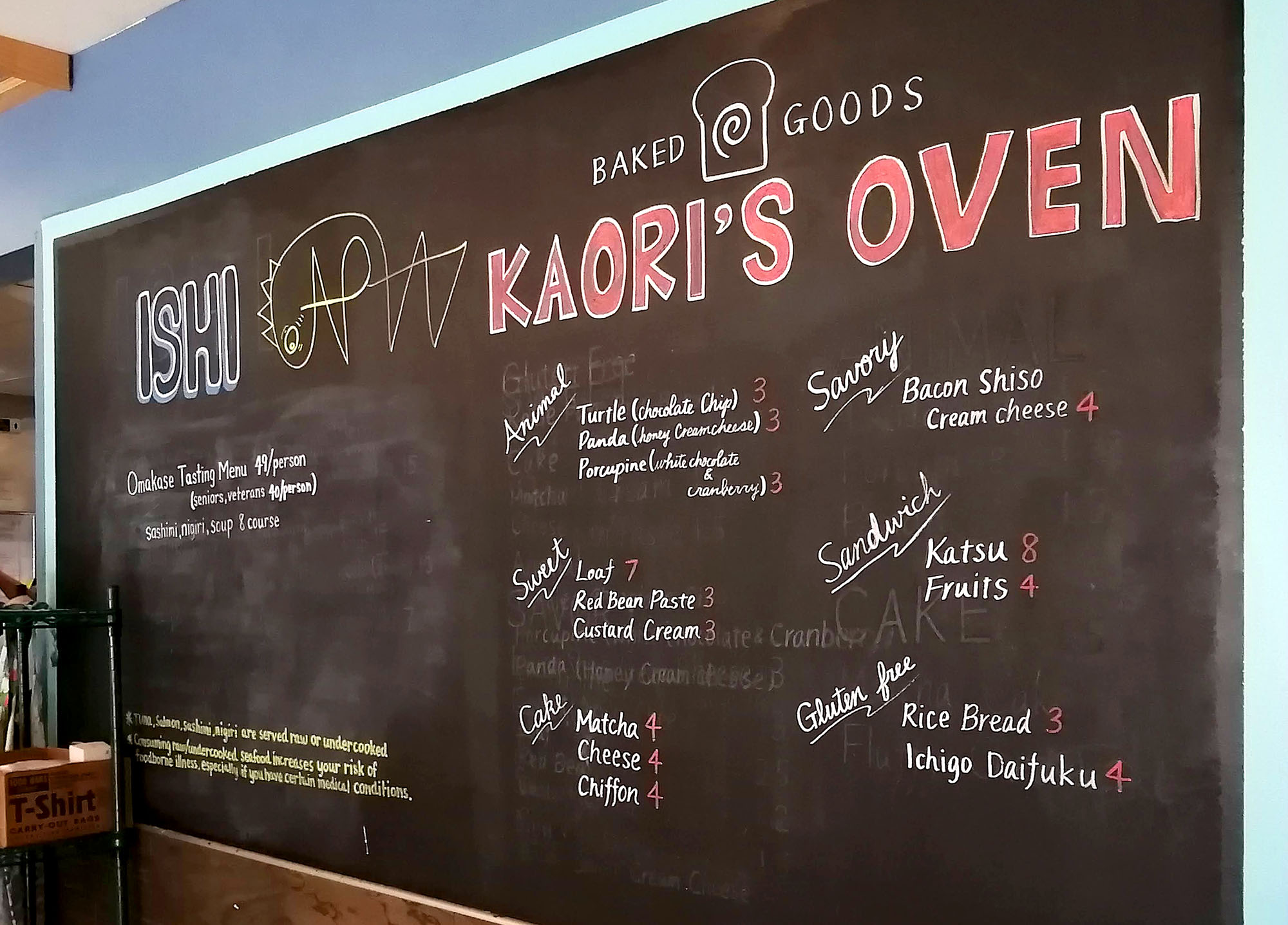
Photo by Paul Young.
While reading the blackboard, my imagination went wild as to what Kaori’s delicious sounding desserts might look like. From our past experience shopping at Mitsuwa Marketplace, we knew Japanese desserts have a clean modern art aesthetic all of their own. I must have telegraphed my anticipation because our friends told us that we will be presented with a dessert tray at the end of the omakase feast.
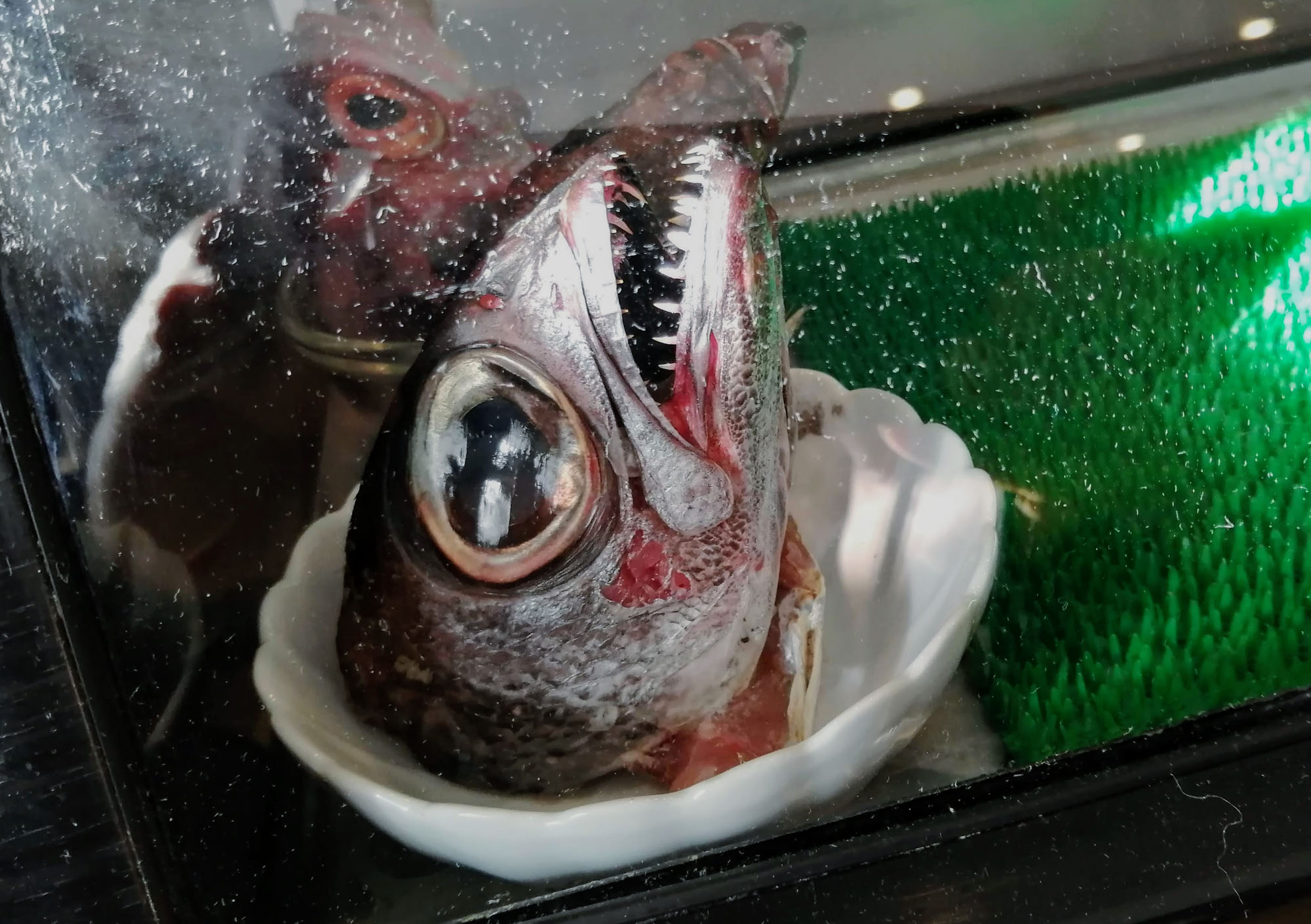
Photo by Paul Young.
When it came time to take our places at the sushi bar, Ken had already supplied us with sake cups, so we poured our first round while staring at a scary looking fish head inside the sushi display case. The fish’s extra large eyes were glassy and clear, a sure sign that the fish served here is very fresh. Despite the fact that there’s a lot of dead fish around, there wasn’t even a hint of that “seafood market” smell — which tells you just how fresh ISHI’s fish is.
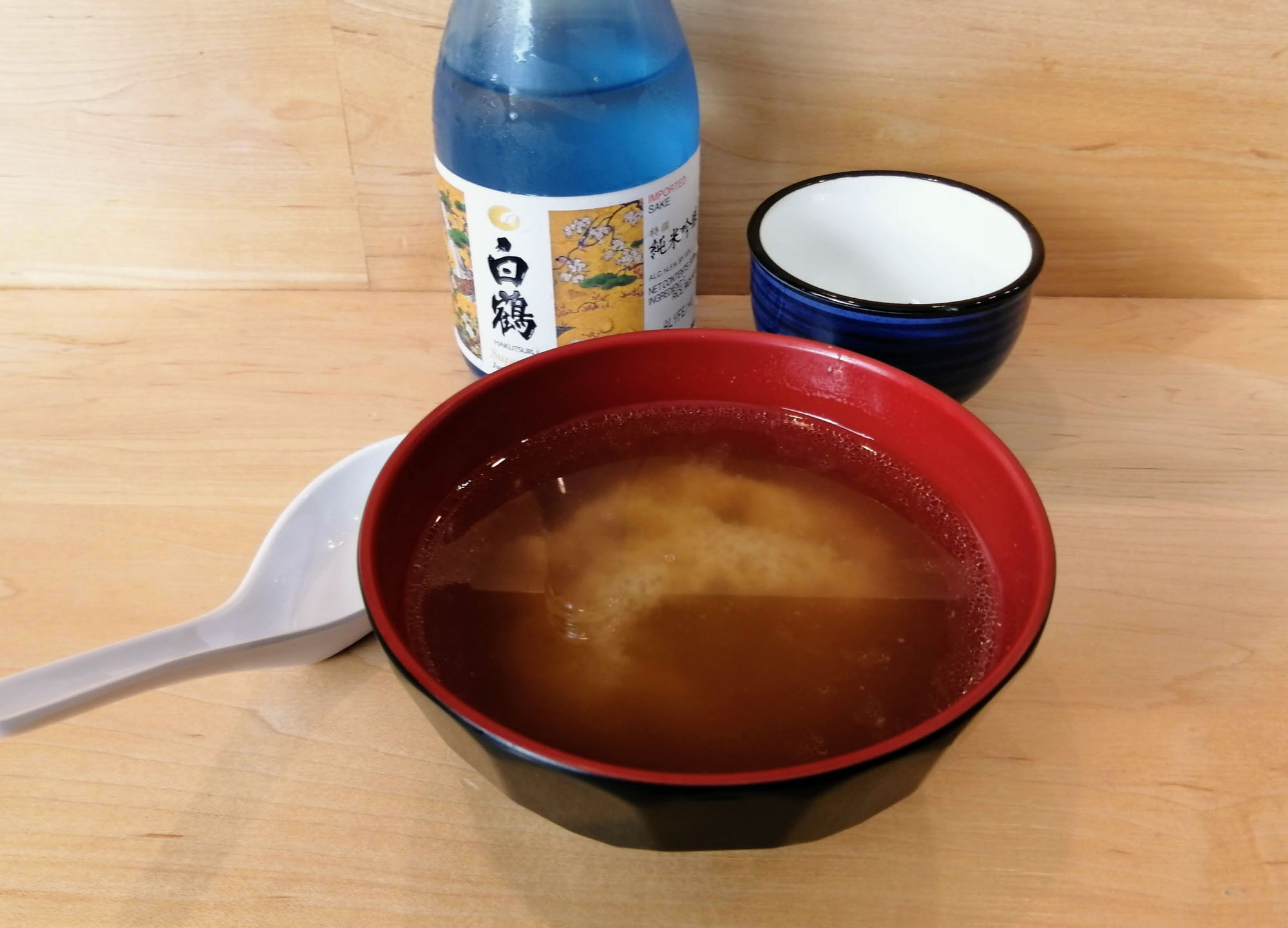
Photo by Paul Young.
Without having to say a word, Kaori immediately brought each of us a bowl of miso soup. Since this omakase experience has a set menu, there was no menu offered, and no specials or options from which to choose. Every course was served at just the right time, in the proper sequence as designed by the sushi chef. Only one thing was missing: the traditional hot towel typically offered at the beginning of a Japanese meal, but that thought quickly evaporated as we took the first sip of our miso soup. The traditional miso soup broth is usually made with kelp and dried bonito flakes, but Ken’s miso soup was extraordinary because it was made with a rich and heavenly seafood broth.
After the meal, I made an appointment to chat with Chef Ishibashi. “Please call me Ken,” he insisted. I wondered what made his broth so special, and he explained that unlike other sushi chefs, he buys the whole fish and breaks it down himself. “I get fresher fish this way, and my fish are never previously frozen. And so, the broth is made with the freshest scraps like heads, skin, and bones which are simmered and then strained. It’s different every week,” he explained. “There’s usually some root vegetables like daikon and carrots, and it evolves with the season.”
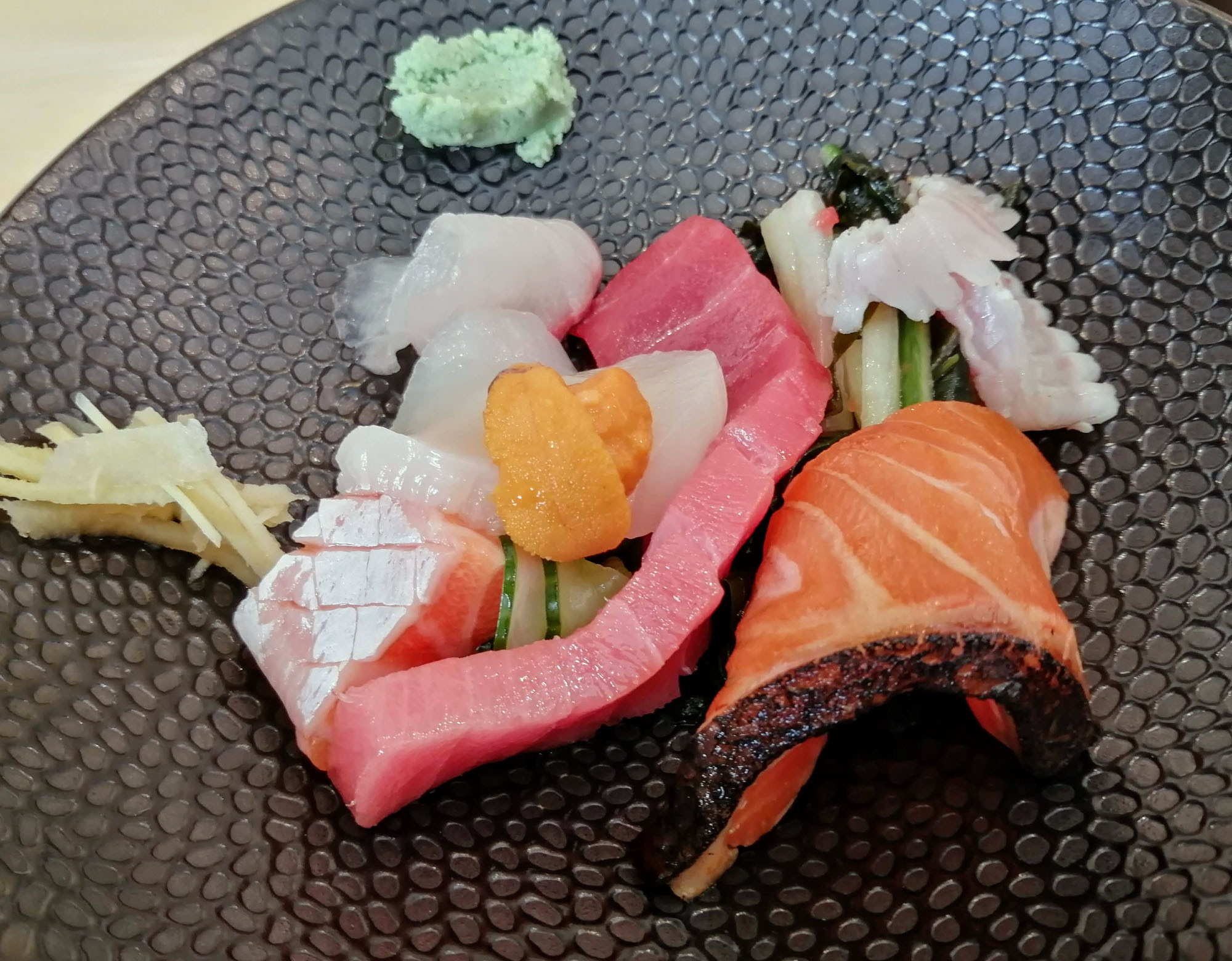
Photo by Paul Young.
For the first fish course, Ken presented us with a sashimi plate. Unlike at other restaurants where each slice of fish is nicely aligned and arranged like fallen dominoes, Ken’s version was more random. If sushi is visual art, then Ken is an abstract painter, using color and texture expressively and spontaneously. Later, he explained that he always starts off the omakase experience with the sashimi appetizer to give the customer a taste of what’s to come, like a teaser sampling. He also revealed that way back when, he was an art student at Parkland College.
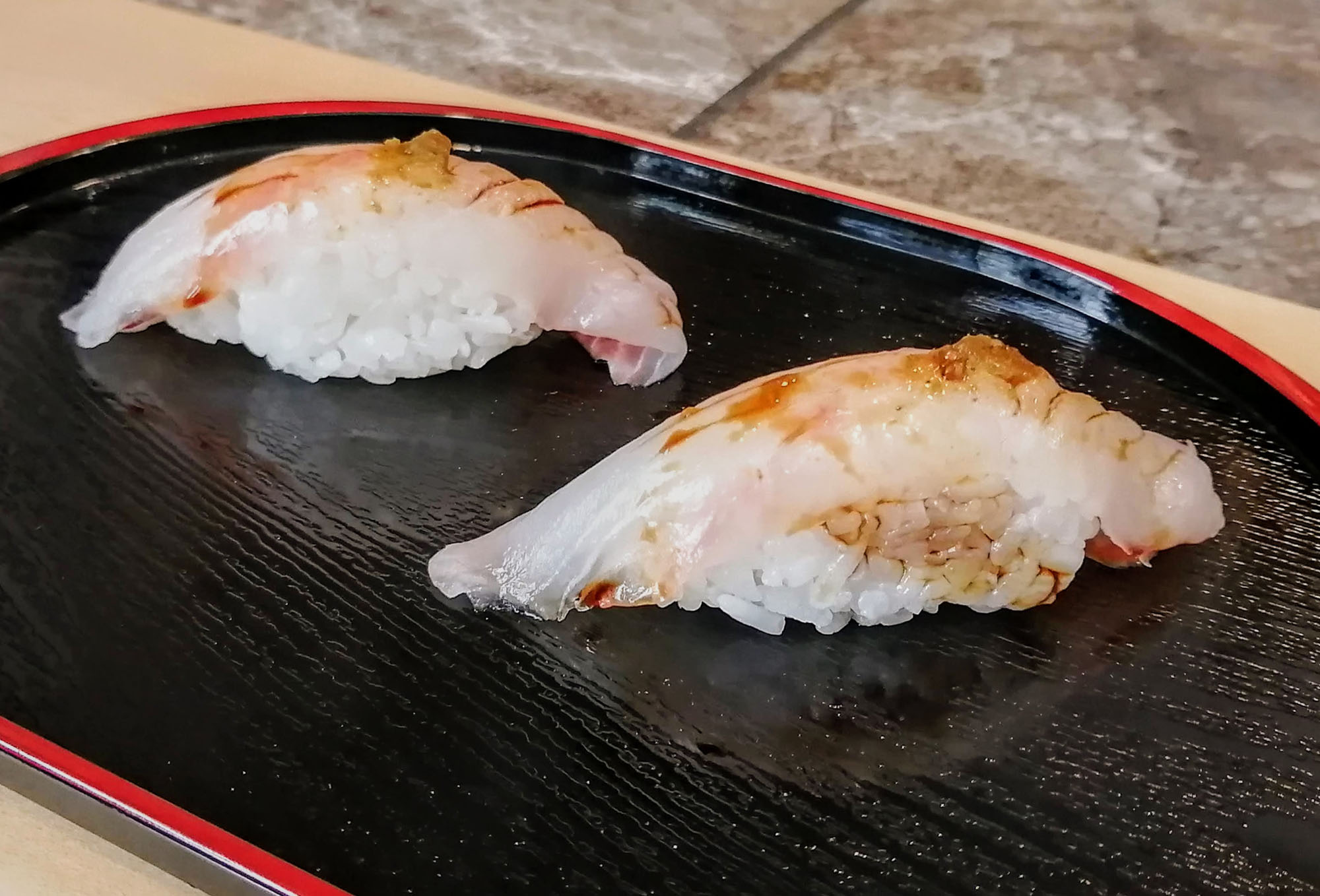
Photo by Paul Young.
After the sashimi appetizer came the first of several nigiri (literally “two fingers” in Japanese) sushi bites. The simplest of sushi preparations, nigiri is just one ball of seasoned rice topped with one slice of raw fish. In this case, the fish was Ishigaki Dai, a rare species of snapper that I have never seen at a sushi bar. The sauce on top was a little soy and a dab of yuzu kosho paste made with a fermented Japanese citrus and pepper condiment. The flavor? Clean and balanced — with just the right amount of salt, tang, and zap. No wasabi or extra soy needed for this bite.
Later, I asked Ken about his philosophy for Japanese cuisine, and he answered with one word: “Simplicity.” When it comes to sushi, what counts for Ken is the freshness and quality of the ingredients which speak for themselves.
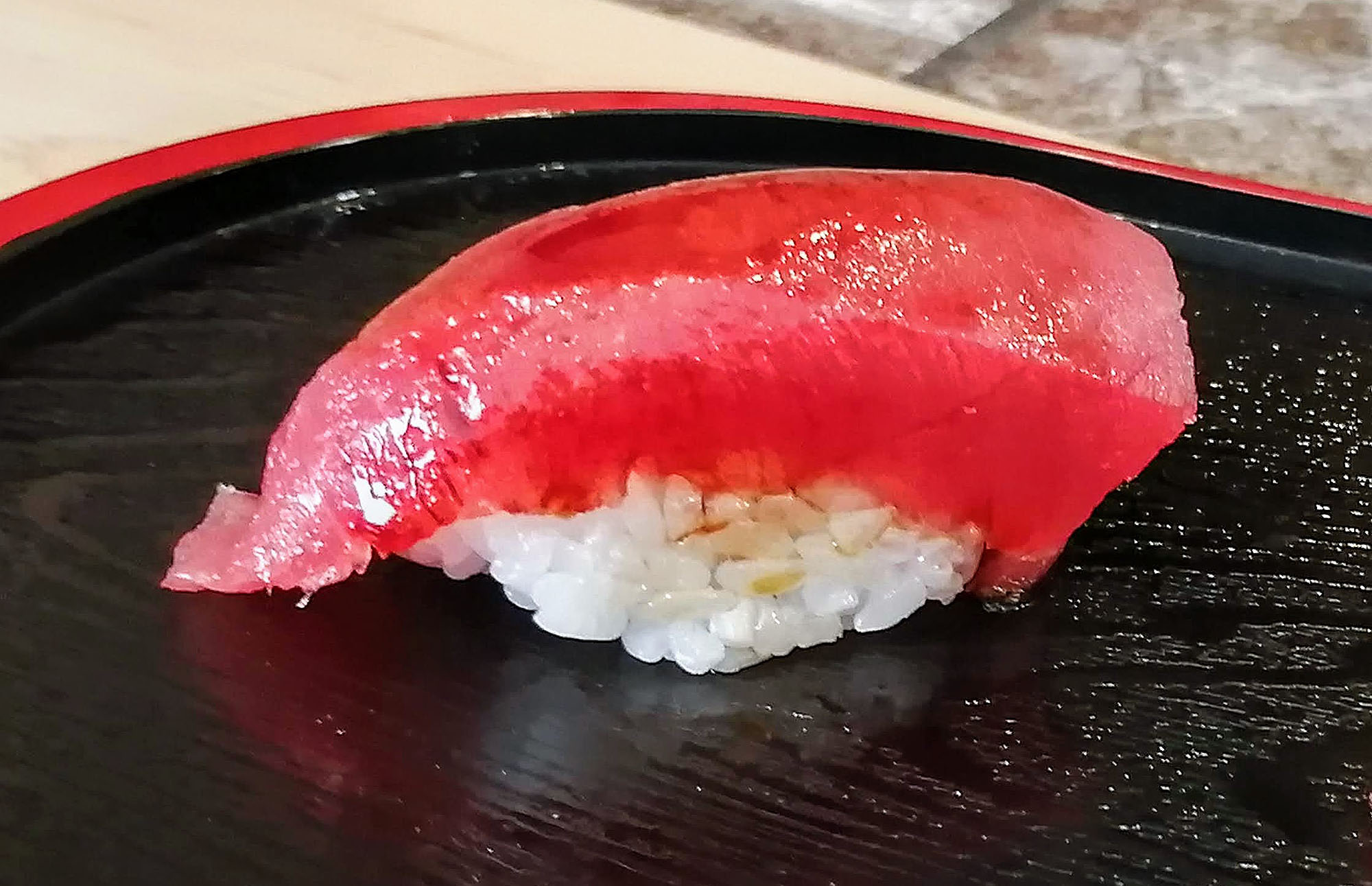
Photo by Paul Young.
The next nigiri placed in front of us was a thick cut of the prized bluefin akami tuna which might cost up to $10,000 for a single fish that can weigh more than 1,000 pounds. Known for its beautiful deep red color, akami is a lean and mild tasting cut with a subtle umami flavor that could easily be obscured with too much sauce. In this case, Ken added just the right amount of wasabi and soy to enhance the flavor — so once again, no extra dipping sauce was needed.
Later, I asked Ken about the scarcity of bluefin tuna which is rapidly disappearing in the wild. “What I get is sustainably farmed. They catch the small tuna, and then let it grow up in a corralled area,” Ken explained. “The bluefin tuna is prized for its high fat content, but it is also the fish that goes bad the fastest, so I’ve just been leaving the saku (‘block’) as is, and then I cut the slices as I need it, so it stays fresher.”
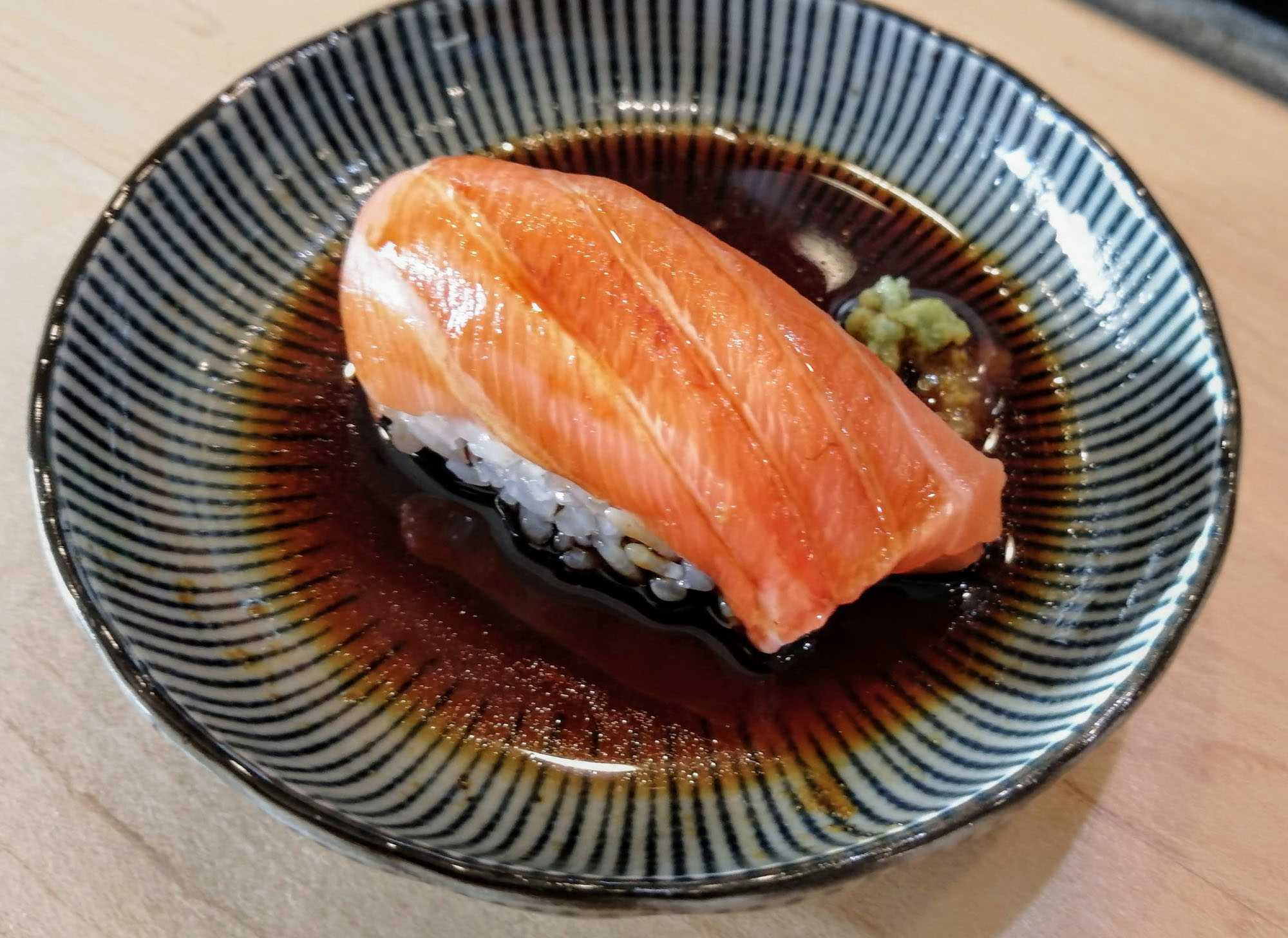
Photo by Paul Young.
Next came the salmon course. Salmon has always been my favorite fish for grilling because the combination of smoke and a light charring enhances its wonderfully mellow flavor. Raw salmon is rather bland by comparison, but what it lacks in flavor, it more than makes up in texture and color — but what Ken served that day blew my mind. This was a toro (literally “melt-in-your-mouth”) cut from the fatty belly — the softest and tenderest part of the fish with beautiful rich strips of white marbling. I like cooked salmon with a garlic-ginger dipping sauce, so for this bite, I added a little extra wasabi and soy sauce to suit my taste. This was my favorite bite — so juicy, soft, tender, and succulent when you first put it in your mouth, but after a moment, the bite kicked back with a wonderful wasabi zap.
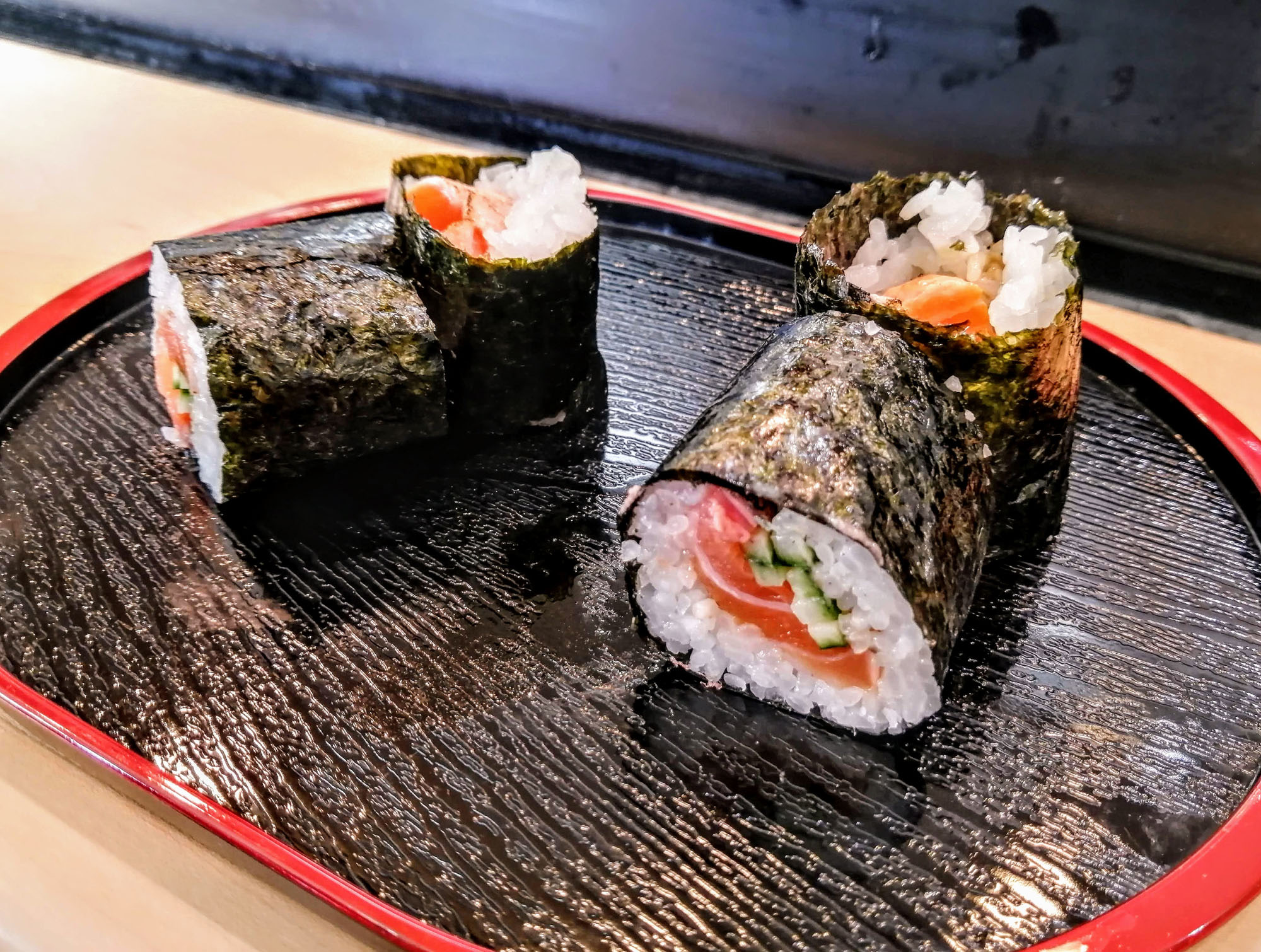
Photo by Paul Young.
Salmon was presented again in the next course, but this time as a makizushi hand roll. “It’s a very simple roll,” said Ken. “I seared the salmon, added some cucumber, and wrapped it in nori (toasted seaweed).” Simplicity was the theme of the day, and I couldn’t agree more that maki rolls do not need to be fancy and stuffed to the gill to be good and delicious.
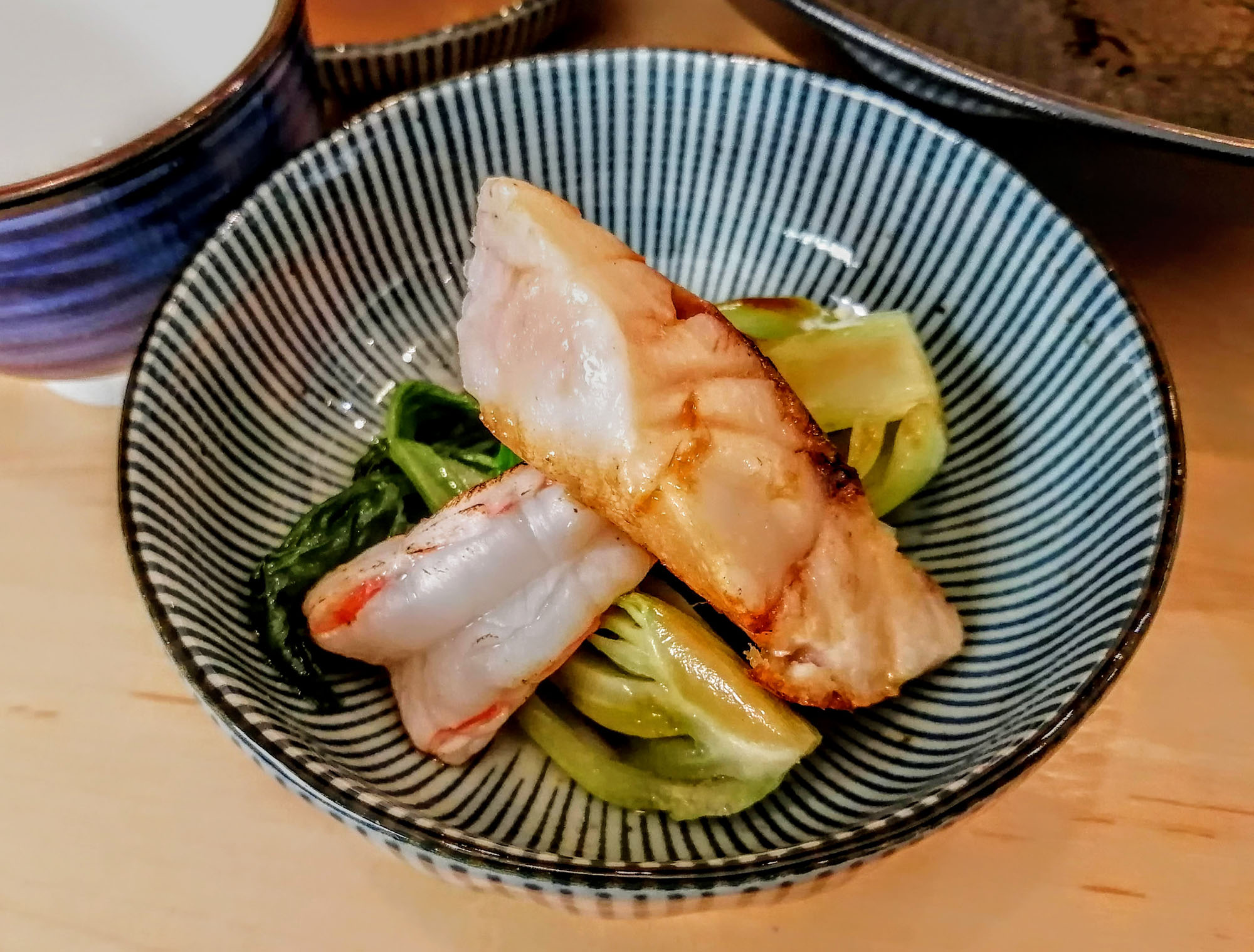
Photo by Paul Young.
The finale was a lovely no name invention of Ken’s that had gently cooked flavors, textures, and color. “For this dish, I started with some gently steamed bok choy flavored with just a little bit of soy sauce, and on top are little pan-seared royal red shrimps from Florida — which remind me of those little sweet raw shrimps — and all that is topped with pan-seared bluefish plus a little squeeze of lemon.” That’s the same fish whose head is on display? “Yep.”
The entire meal was a beautiful performance art experience as designed and directed by a master. From the zen-like atmosphere and Ken’s verbal description of each dish to the perfect pacing, the rhythm, the tease, the twists, the build-up to the climax — everything was planned and executed perfectly. Even the portions were carefully considered so that there was room left for dessert — the much-anticipated epilogue and the only part of the show where the audience was offered a choice.
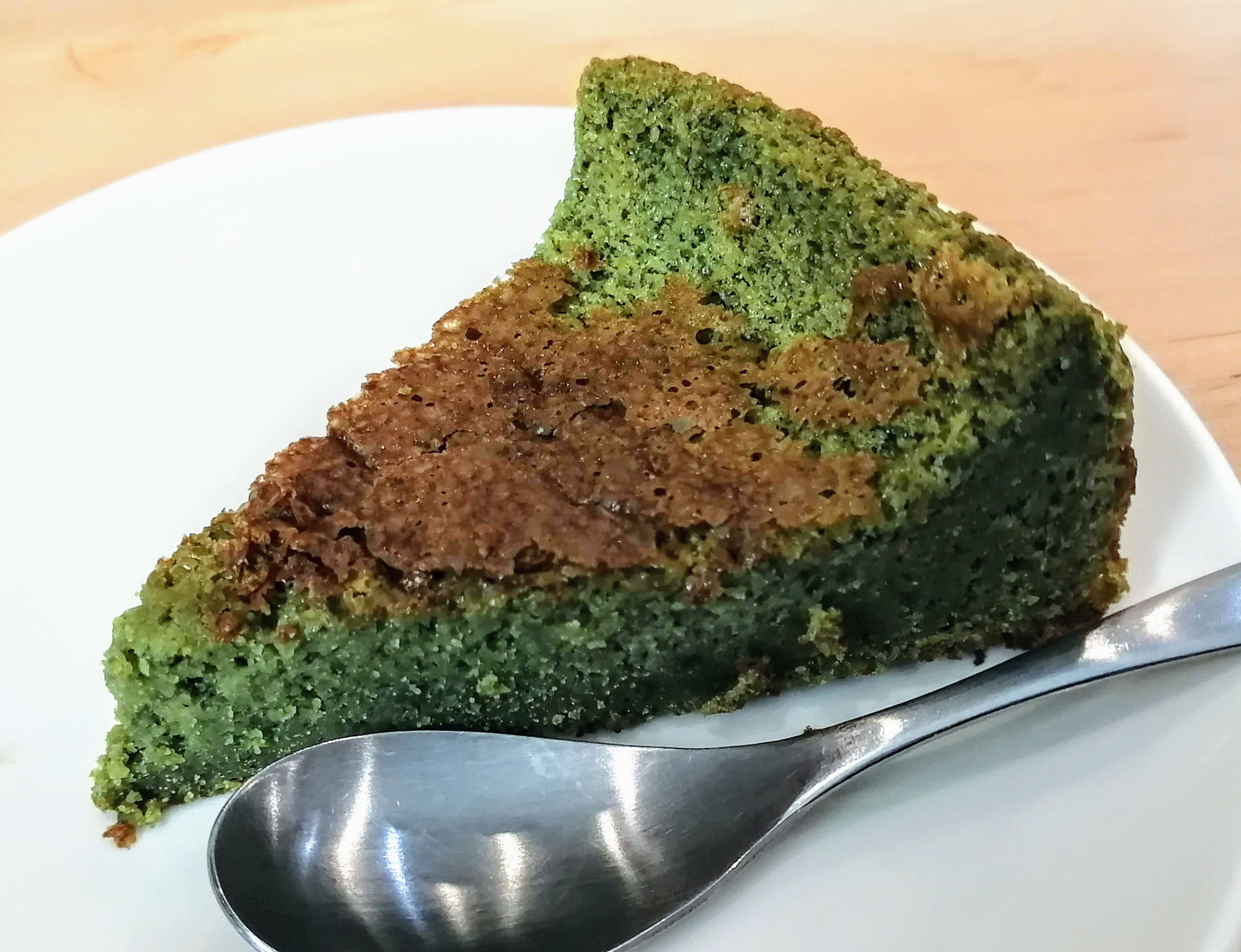
Photo by Paul Young.
As previously foreshadowed, Kaori presented us with a tray of four beautiful-looking desserts ($4 each). I chose the matcha cake made with powdered green tea and white chocolate which was topped with a little cocoa powder for color. I don’t like my desserts super-sweet, and this moist and luscious cake fit the bill perfectly.
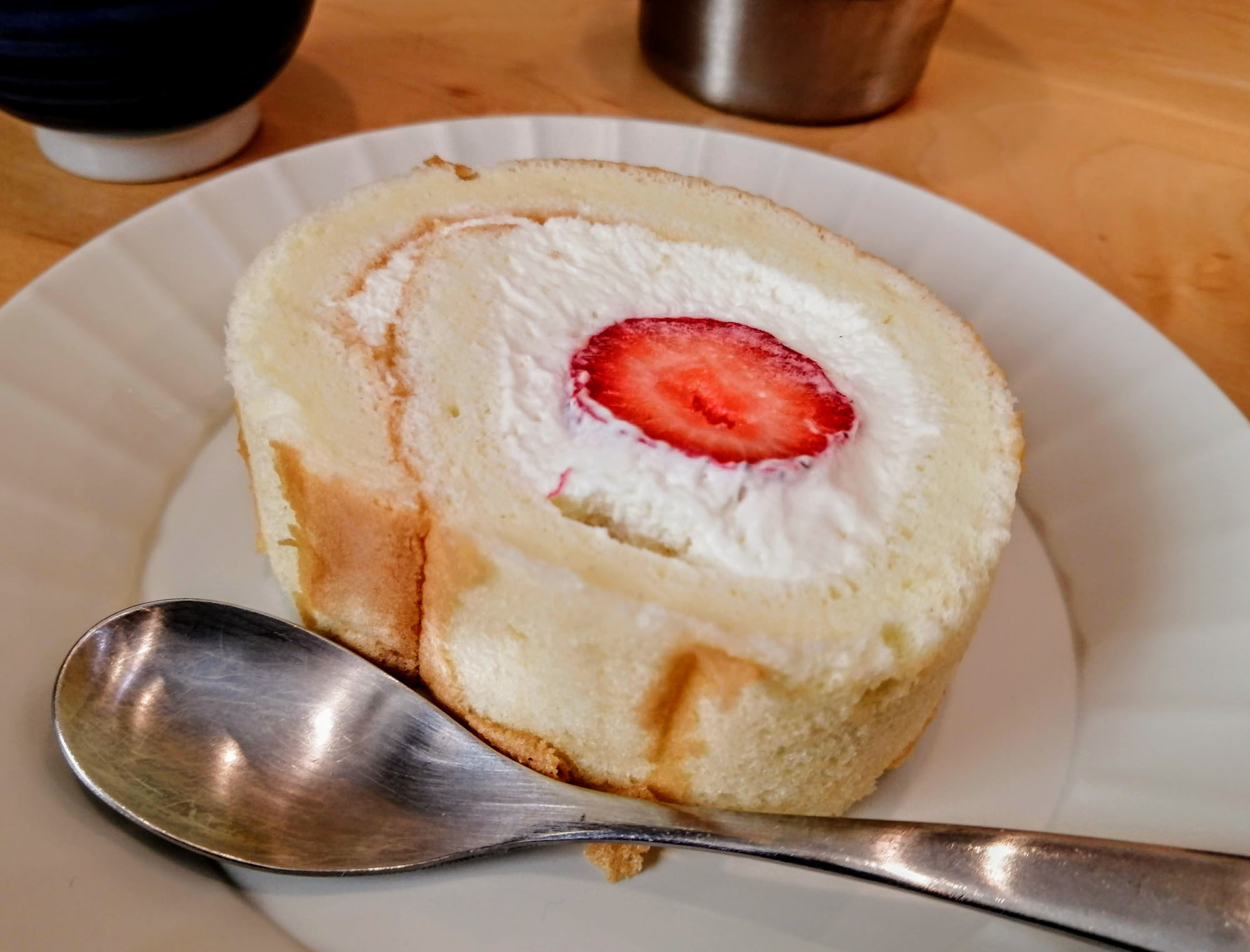
Photo by Paul Young.
My partner had the roll cake, a strawberry shortcake prepared like a maki roll with a strawberry nestled inside a bed of whipped cream before being wrapped in a white flour cake and then sliced for serving. Another creative invention presented beautifully and simply.
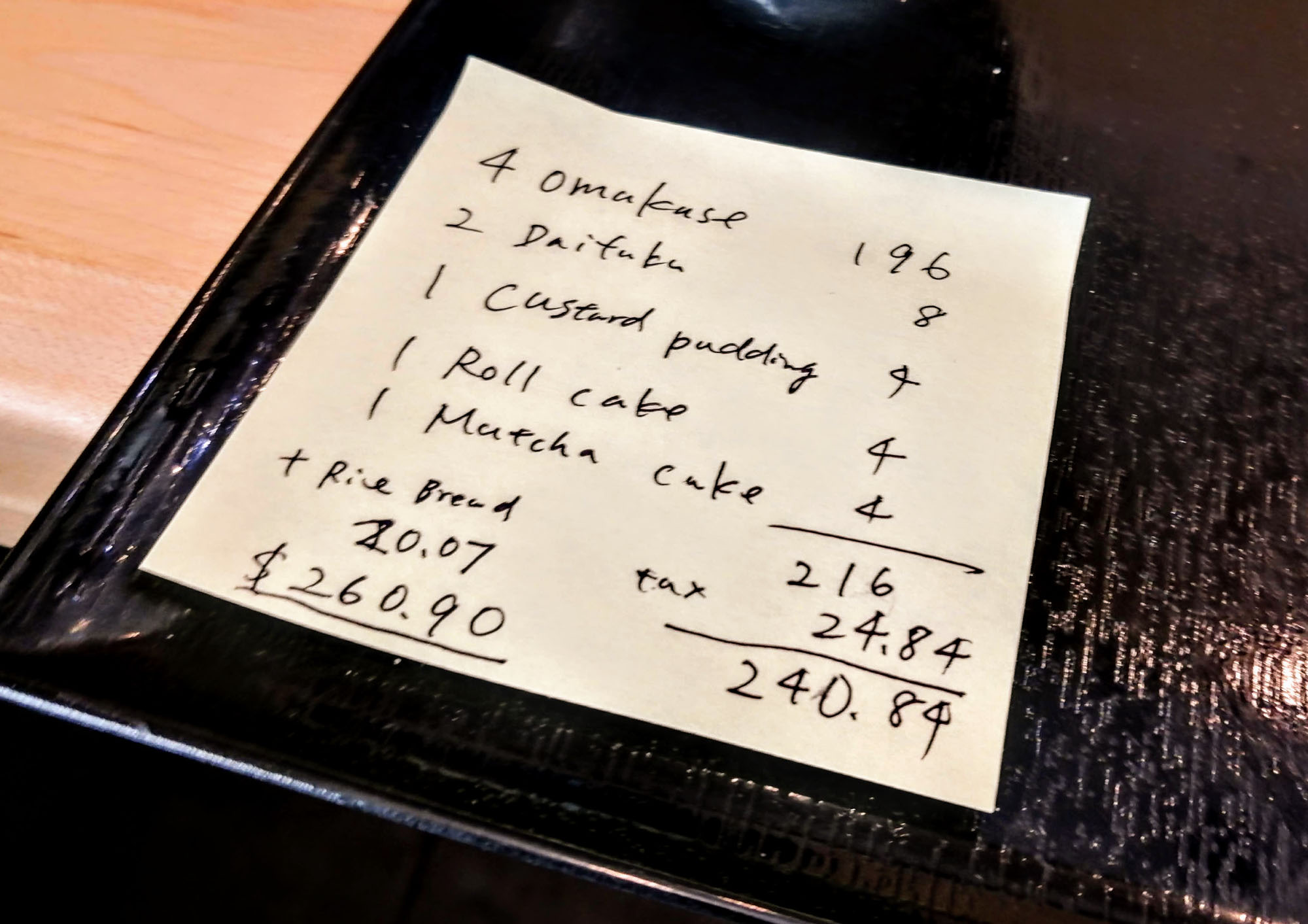
Photo by Paul Young.
Even the check was presented simply: a hand-written note on a post-it pad. “That’s the best we can do at the moment,” Ken explained later, almost apologetically. No apologies needed, I thought, just another brilliantly simple and inspired design decision in my humble opinion. I wouldn’t change a thing.
The final tally without the extra to-go rice bread that our friends ordered: $54 per person before tax and tip. Compare that to the $300 omakase experience you might be forced to pay for if you lived in San Francisco — another reason I’m so glad that we live here in Champaign-Urbana.
That extra rice bread that our friends bought? It’s gluten-free. Although it’s available regularly by the slice, our friends like to stock up every time they come, so they always pre-order a loaf or two. Is sushi gluten-free? “It can be,” said Ken. “And if given proper notice ahead of time, I can accommodate other dietary restrictions as well.”
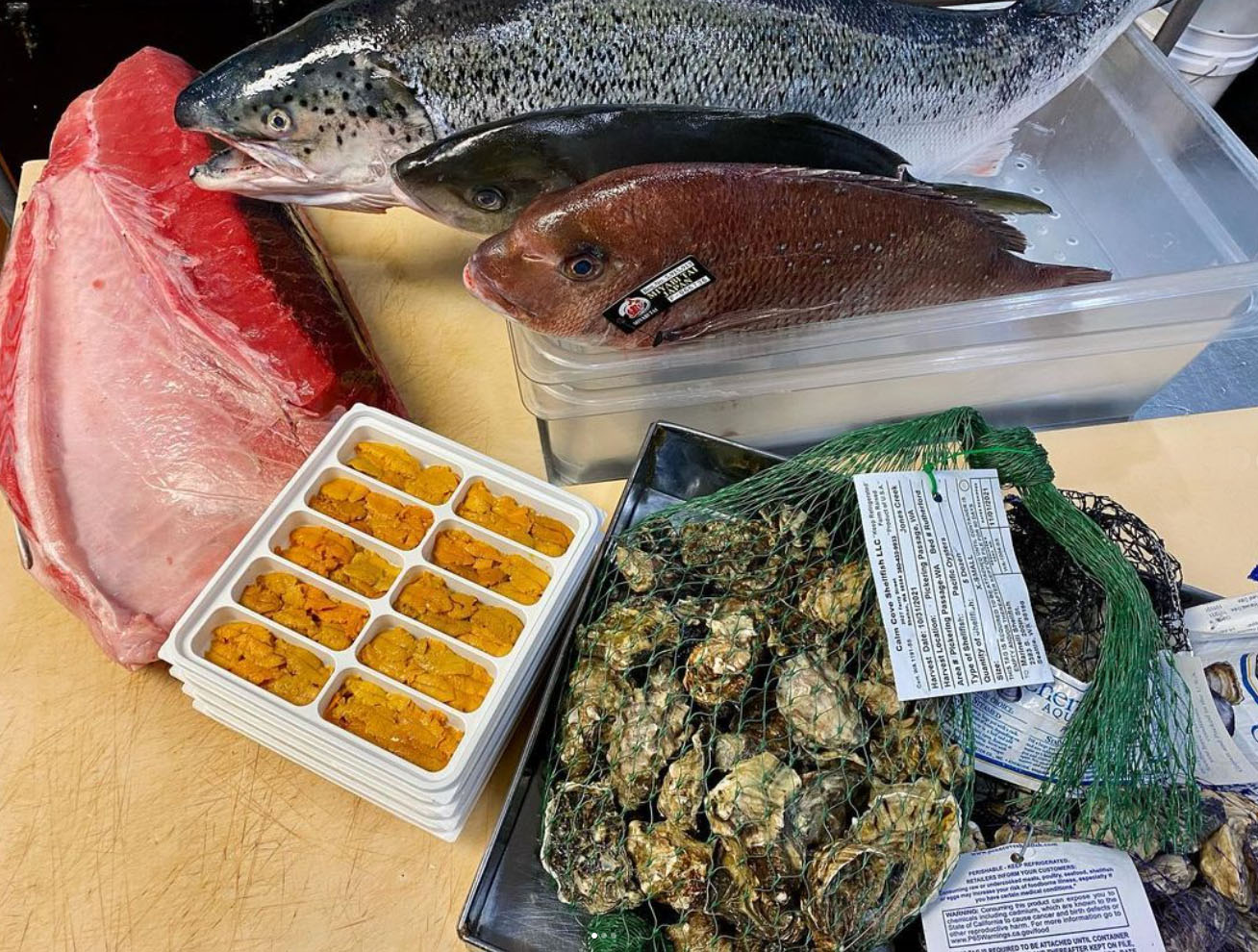
Photo by Ken Ishibashi.
When I returned a few days later to chat with Ken one-on-one, I wanted to ask him about the two most important elements of sushi: the fish and the rice.
“So I get the fish in once a week on Wednesdays, and I start to break it down immediately,” explained Ken. And where does the fish come from? “My distributor is in Chicago, but they source from all over the world. Like the best salmon is Atlantic salmon from Norway or Scotland, and some of the other fish is directly from the Toyosu fish market in Tokyo. The selection changes every week.”
Obviously, rice is an important component, and many sushi chefs have been quoted as saying that careful rice preparation is what makes good sushi. “Fish is the second ingredient,” claims sushi master Naomichi Yasuda on Anthony Bourdain’s Parts Unknown in 2013. “The main ingredient is rice. So my sushi is rice,” he exclaimed. So I asked Ken if there is something special or unique about the way he handles sushi rice.
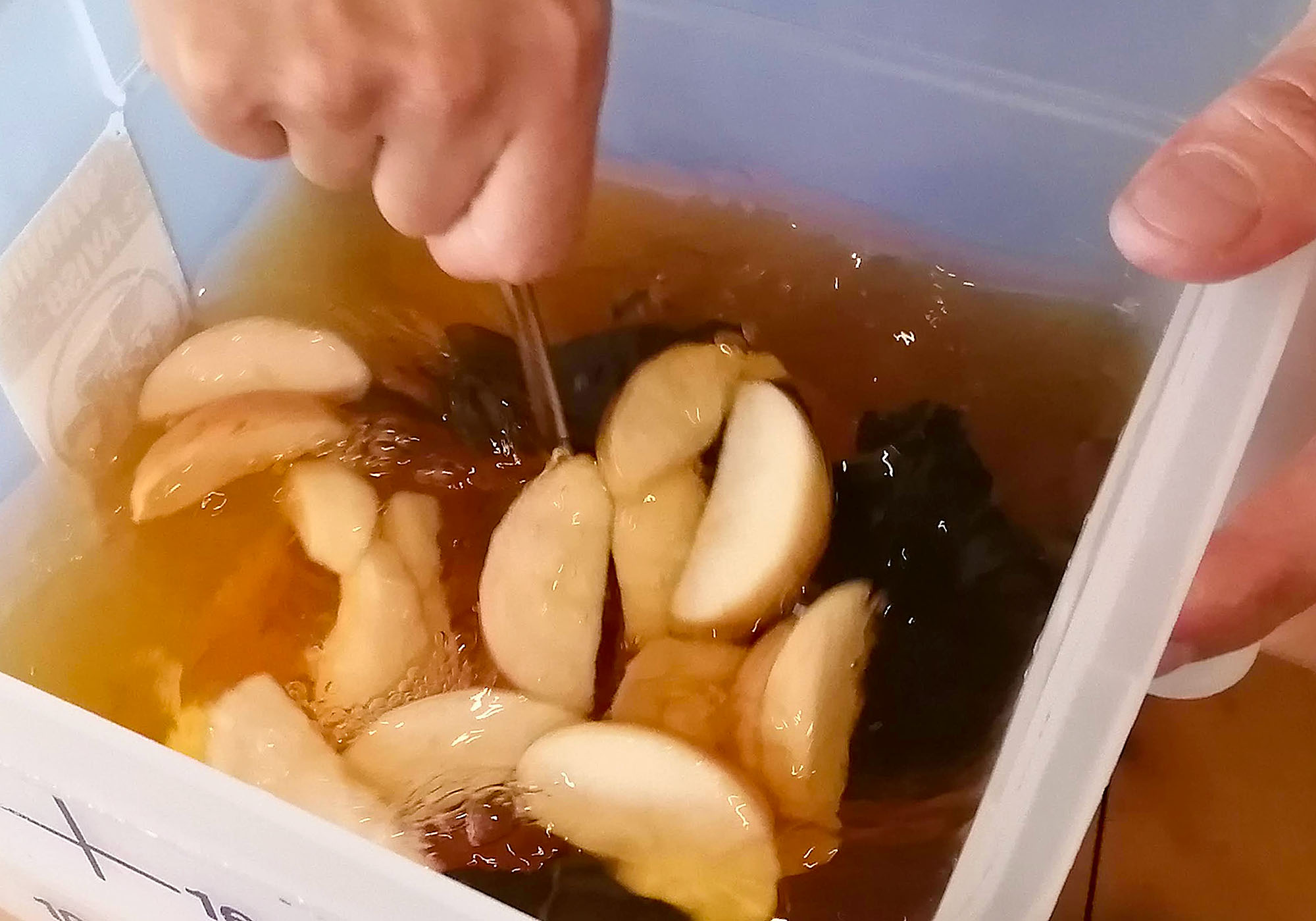
Photo by Paul Young.
“You know, rice is about timing,” said Ken. “You don’t want it too soft, and you don’t want it too hard. I have a personal preference for making my rice kind of firm, like al dente.” And the seasoning? “This is where sushi chefs can add their own special touch,” Ken explained. “The tradition is a subtle sweet-and-sour flavoring made with sweetened rice vinegar. So I add a little sake and mix in a little sugar, and then I also add lemon and apples, too. Here, I actually could show you.” Ken pulled out a bucket of aromatic liquid which is used exclusively to season the rice. “Yeah, and every week it’s slightly different,” he added.
I also wanted to know how Ken and Kaori handle a typical work week. “Monday and Tuesday are our days off, and then she’s open on Wednesday and Thursday for the bakery. On Thursdays, we do private dining, which we also sometimes do on Wednesday. Fridays and Saturdays are our omakase days by reservation only. On Sundays, we do a lunch service for walk-ins. I try to plan it out so that everything is gone by Sunday, so we can start again next week with everything new.”
So if someone wanted to reserve a seat at this special omakase experience, how would they do that? “Recently, I’ve been doing everything by text messages,” replied Ken. “Every month, I send out a text to my regulars, and they can just reply and let me know which date they want to pop in. It’s kind of a personal thing, it’s like, if I know your name, then all you have to do is send me a text. That’s all.” And if you’re a new customer? “You can text me at 217-254-5653, and introduce yourself. That’s the same number on my Facebook page.”
If one wanted a private dining experience, how does one arrange that? “Same way, just make contact. We’ve found that there’s a sweet spot when a party of six books a private dining experience.”
If only the world were as simple as that. Make contact. Become a friend. Get invited for dinner — only in Champaign-Urbana.
ISHI & Kaori’s Oven
305 Cedar St
Champaign
ISHI Sushi
F+Sa reservation only
Su noon to 2 p.m.
Kaori’s Oven
W-Th 9 a.m. to 11:30 a.m.
When he is not watching one film a day, Paul Young likes to travel the world seeking good things to eat. So far, he has eaten his way through 25 countries, and he loves to share his culinary discoveries with cooking classes.








